Light, medium & heavy tanks, armored cars
Around 2600 armored military vehicles built by September 1918
Tanks
Medium Tanks
Armored Cars
Other vehicles
Prototypes & Projects
Patent Designs
Pre-WW1 Vehicles
Tactics
Fictional/Fake Tanks
Tank Week – Fund Raising Tanks
List of towns and cities visited by WW1 tanks during Tank Week
Breaking the Stalemate
Just like the French, the British commanders saw all of their offensives pinned down by relentless enemy machine-gun fire. As early as 1915, marching into the open was seen as suicidal. Obstacles like the bombed landscape, the deep muddy ground and barbed wire also contributed to slow down any assault and render it virtually impossible without immense casualties. While the Germans managed to find a way to use elite infantry (the Stürmtruppen) for assaults, both the British and the French started thinking of a way of delivering infantry literally to the enemies trench entrance, dealing with casemates and machine-gun nests, and protecting infantry in no-mans land. Besides this, H.G. Wells’ steam and pedrail wheels from the famous “The Land Ironclads” of 1903 were in the minds of most politicians and officers.
One engineer in particular had a tremendous impact on the tank development in Great Britain, William Tritton, Managing Director of Fosters. He designed the “Little Willie”, a prototype for testing many features later used in the “Mother”, the prototype for the first British operational tank, the Mk.I, and later the “Whippet”, the first British light tank. Also very important were Major Walter Gordon Wilson and Major General Swinton. Supporting them was the “Landship Committee”, headed by Sir Winston Churchill. The specificity of using caterpillar tractors, in large use by the army for towing artillery guns, led to the rejection of this idea by the War Office at first, and its adoption and development by the Royal Navy. Naval guns, sponsons and most of the vocabulary also came from the Navy, reflected in the genesis of the Mark I and following models. The very name “tank”, a code name to deceive spies, was used to cover the first experiments at the English Lincoln William Foster & Cie. In fact, factory workers were told that they were assembling “mobile water tanks” for operations in Mesopotamia.
War Production
The British engineers devised an original approach to the trench crossing problem. Contrary to the French, whom basically developed some kind of armored boxes above a modified Holt chassis, their solution was a very long track, basically covering the entire length and height of the hull. The famous rhomboidal-shaped profile became an iconic visual landmark in tank history, immediately identifiable with WWI armored vehicles. The solution proved well adapted to the worst terrain imaginable. The Mark I however had the engineering problems of its time: too heavy for its engine, too slow and lacking agility, uncomfortable for the crew with no hull compartmentation (leading to poisoning from hot carbon gases), unbearable noise, and a rough ride. If in idea these tanks were protected, on impact the plates produced small shrapnel-like splinters on the inside of the vehicle.
Soon enough, the Germans learnt how to use mortar shells, grenades, the newly developed hollow charge “K bullet” and direct fire from artilleries against the British tanks. These limitations produced an amazing attrition rate through the first operations, during the Somme Offensive in September 1916.
Many broke down at the start, others were bogged down in large craters or broke down en route, and the rest were dealt with by German artillery. The one third which survived, however, did their job. The first offensive was a success despite terrible losses and lack of coordination, mostly thanks to the shock and awe produced by their appearance in the German lines. They also had a tremendous propaganda value, and triggered a sudden, somewhat irrational morale boost in the infantry ranks, which was badly needed after repeated failures.
After the Mark I, the Mark II was produced only for training purposes, but nevertheless, also put in action in later 1917 offensives, with disastrous effects.
The Mark III was also a training version, with some improvements which will be seen on the upcoming Mark IV and Mark V models. The Mark IV was the biggest production of the type: 420 males, 595 females and 250 tenders (supply tanks).
They incorporated early war experience in a single package, with a more powerful engine, better armour, a relocated fuel tank, and retractable sponsons. Three of them (two females and a male) fought during the second battle of Villers Bretonneux, in April 1918, against a rare German A7V. This turned into a duel between the British male and the German tank, which ended in a draw. The Mark V appeared in late 1917, but was only available in quantities by mid-1918.
This was the last wartime evolution of the type, featuring several minor improvements, including a new, long-awaited gearbox and steering system. The original Mark V was supposed to be a brand new, far more ambitious design, but because of concerns about delays on the production lines, it was ultimately rejected for a more pragmatic approach, based on the Mark IV, itself driven from the Mark III.
Apart from 200 males and 200 females, some were converted later as “hermaphrodites”, bearing a gun in the left sponson, and two machine guns in the right one. They were put to the test on the 4th of July 1918, during the Battle of Hamel, in which 50 supported the Australian troops advance. After the war, some fought with the Russian “Whites”, and were ultimately captured by the “Reds”.
In 1918 a different tank appeared under the official designation of Medium Mark A, soon called “Whippet”. It was not truly a light tank, but with half the weight of the Mark IV and a pair of torque-abundant engines (also used in the London two-decker buses of the time), it was considered fast by those times standards, designed to exploit breakthroughs on the battlefield made by heavier tanks. This led, in 1918, to the development of a separate branch of fast medium and heavy models.
Medium Mark A “Whippet” tank
by SebastianSosnowski
on Sketchfab
1919 Projects and Early 20s Developments
By 1918 the Mark V was considered nearly obsolete. New projects included the Mark VI, with a completely redesigned hull. But in 1917, although a mock-up and detailed plans were ready, the committee decided to stop it in favor of the new joint US-British project, the Mark VIII “Liberty”. The Mark VII was a separated project, developed in 1917 as an improved Mark I with a lengthened hull, a new revolutionary Williams-Janney hydraulic transmission and an electric starter.
Out of an order of 75, three were ultimately produced and only one delivered and tested in France. The Mark VIII, was designed for mass production both in Great Britain and the USA, with a joint design filling both countries requirements. It was basically a redesigned, lengthened model (13 m or 42 feet) with the greatest trench-crossing capabilities ever achieved, a turret-like fixed superstructure with multiple machine guns, and a howitzer mounted in the front hull.
It came too late for WWI, but 100 were built by the Rock Island Arsenal, 40 by the Manchester Tank Syndicate and 11 by the North British Locomotive Co in Great Britain. They served until the thirties. The Mark IX, dubbed the “Pig”, was a specifically designed supply tank and troop carrier, of which 34 were ultimately built out of an order of 200. A special amphibious model was also tested successfully, known as the “Duck”.
The British Mark A Whippet also proved a sound concept and enjoyed several improvements in the field, mostly attempted by Major Philip Johnson of the Central Tank Corps Workshops in France. He fitted one with leaf spring suspensions, sprung track rollers, and later modified it even further with an epicyclical transmission from a Mark V and a powerful 360 hp V 12 Rolls-Royce Eagle. This led to the fastest tank ever built during WWI, capable of 48 km/h (30 mph). Johnson will work on the later Medium Mark D project.
The Mark A was followed by the Mark B, Lieutenant Walter G. Wilson devising a brand new, bigger (18 tons) design, with a forward superstructure, the engine at the rear, longer tracks with a rhomboid chassis and a frontal sloped glacis plate. It looked like a mix between all previous designs, bristling with five machine-guns in mini-sponsons. However, due to the rival project from Tritton, the Mark C, only 102 were produced out of an order of 450, and only 45 were accepted in service by the end of 1918. They only served in France for a couple of weeks, all others being scrapped.
The latter, called the “Hornet” was designed by Tritton chief designer William Rigby. It incorporated many improvements from the Whippet, along with a forward superstructure, a rhomboid track, sloped frontal armor and more powerful engines. It was also heavier, but its speed was still excellent. It met all requirements for the army and 6000 were ordered in 1918. None was delivered until the end of WWI, and only 50 were completed in 1919. Some served in Russia and those that remained in Great Britain were ultimately replaced by the
Medium Mark I.
WWI British Tanks
200 built. Males armed with two 6 pdr and 2 Lewis or Vickers machineguns in sponsons. Females armed with 4 Lewis machineguns and one Hotchkiss machinegun.
50 built. Not protected. Training only.
50 built. Improved version. Training only.
1120 built. Many improvements. Frontline tank until 1918.
400 built. Only available in early 1918. Many improvements, last evolution used during the war.
30 built. British variant of the joint US-British “liberty” design.
200 built. Four or Two Vickers or Hotchkiss machine-guns.
36 built. First purpose-built APC.
50 built. 150 mm howitzer SPG.
WWI British Armored Cars
120 built. Lightly armored. One Lewis or Vickers machine-gun.
36 built. One Vickers cal.303 LC machine-gun.
180+ built. One Vickers cal.303 LC machine-gun.
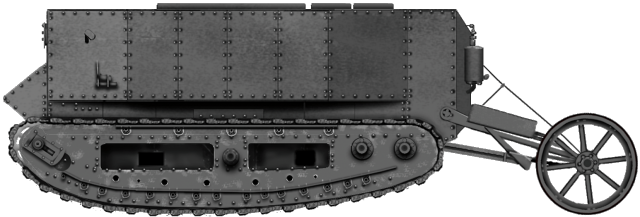 ‘Little Willie’ was created in 1915 and is wildly regarded as the World’s first tank. This was the prototype that led to the creation of the Mk.I Tank.
‘Little Willie’ was created in 1915 and is wildly regarded as the World’s first tank. This was the prototype that led to the creation of the Mk.I Tank.

The Mk.I Tank was the first of the ‘rhomboid’ tanks. It made its combat debut at the battle of the Somme in on September 15th, 1916 at Flers-Courcelette. Results were mixed with many breaking down. At least a third of the vehicles succeeded in breaking through, however.
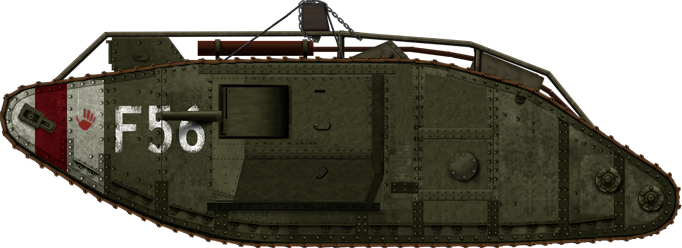
With the rhomboid design refined, the British continued to produce tanks of this shape. The MK.IV was the tank that Britain built the most of. Over 1000 of these were produced, they debuted on the battlefield in 1917.
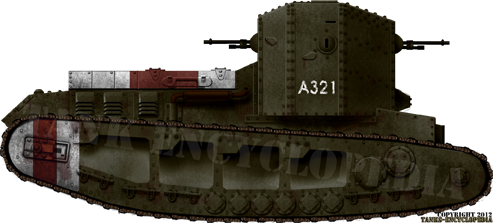
The Medium Mark A was designed as a somewhat more mobile alternative to the ‘rhomboid’ tanks. They were armed only with machine guns, and appeared on the battle field late 1917, early 1918.
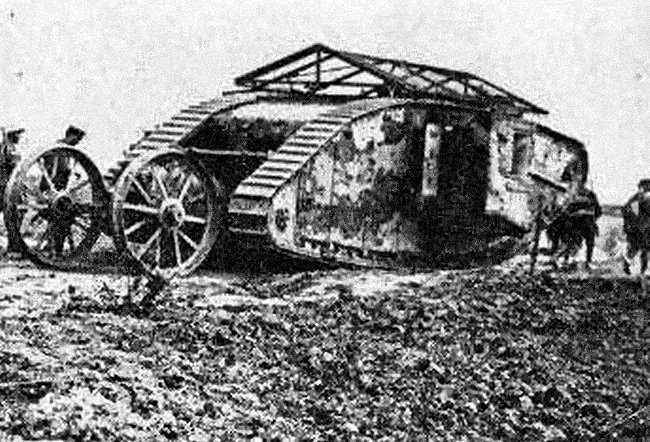 A Male Mark I Tank with all its battle-gear, early 1917. The rear tail-wheel was meant for better steering, and the “roof” was made of a grilled framework to deflect grenades. The upper armor could barely stand against grenade shrapnel – Credits: Tanks!
A Male Mark I Tank with all its battle-gear, early 1917. The rear tail-wheel was meant for better steering, and the “roof” was made of a grilled framework to deflect grenades. The upper armor could barely stand against grenade shrapnel – Credits: Tanks!

A Male Mark V composite (with two guns in sponsons) in Estonian service by 1920 – Credits: Wikimedia.
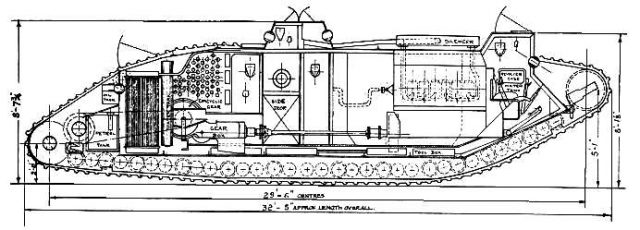
Diagram of a Mark V* (star) – Credits: Panzerfaust.de
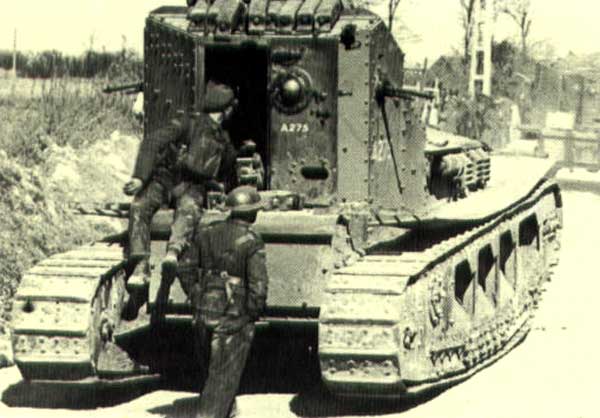
The Mark A “Whippet” was a real improvement as a concept, introducing some tactical agility on the battlefield. Only 200 were produced until the end of the war.
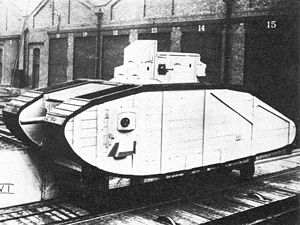
The Mark VI mock up. No prototype was ever built, as this improved version was dropped in favor of the Mark VIII “Liberty”.
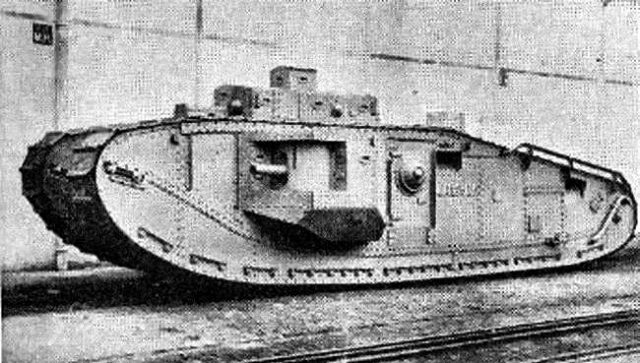
The Mark VIII Liberty, a joint Anglo-American project, planned to be built in France en masse, but later cancelled and built in both countries and small series after the war. It was the last evolution of the “lozenge” or “rhomboid” heavy tank type – Credits: Tanks!
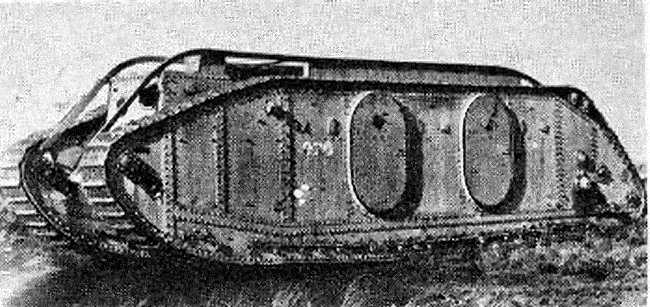
This massive model, called the “Pig”, was the first troop-carrier built in Great Britain. Only a handful were operational in time, but most were used as supply tanks. They were considered underpowered. Another amphibious variant, the “Duck”, was also produced – Credits : tanks!
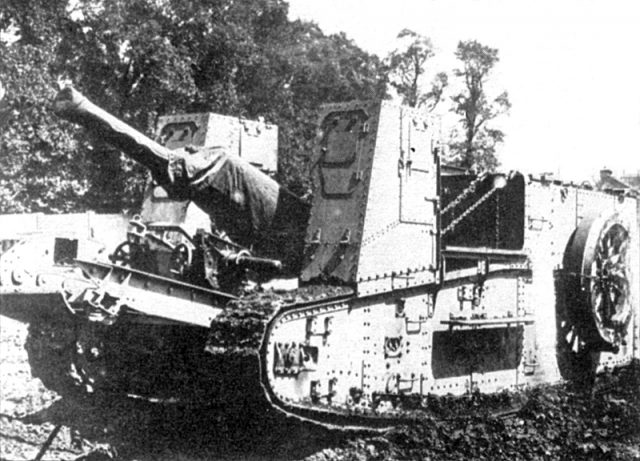
Gun Carrier Mark I. This was the world’s first SPG (self propelled gun), with a 150 mm howitzer for mobile artillery support – Credits: Wikimedia
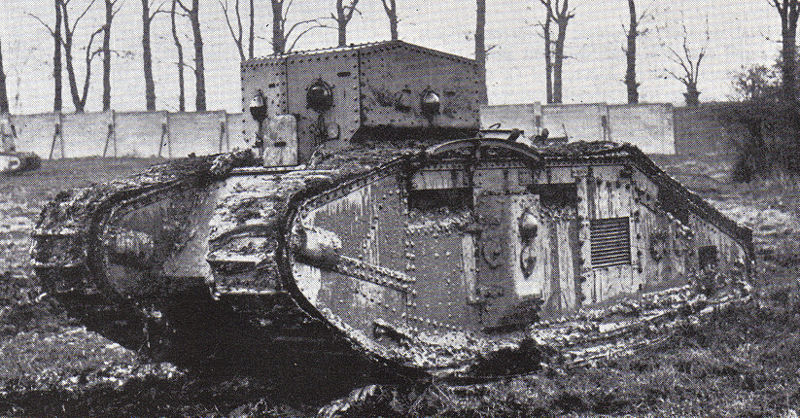
The Mark B “Whippet” was a project by Major Wilson, which previously worked on other William Tritton designs. William Tritton’s efficient lobbying promoted his own Mark C, and ultimately only 102 Mark B were delivered, before and after the end of WWI – Credits: Wikimedia
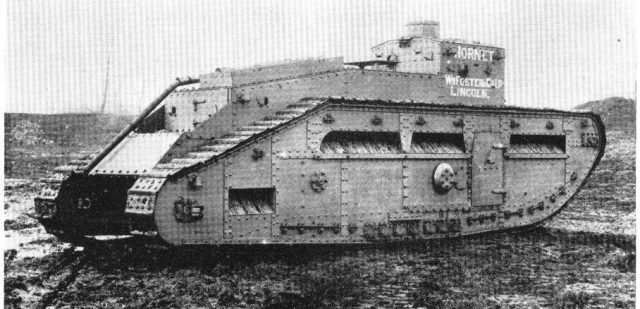
A Mark C “Hornet”, Tritton’s successor for the “Whippet”. Only 50 were completed after the war – Credits: Wikimedia.
Centennial WW1 POSTER

Illustrations
 Tank Mark II “The Flying Scotsman”, now in Bovington, as it was painted when it was sent to France, battle of Arras, April 1917. Most were knocked out relatively easily by German troops already trained and equipped with the “K” armor-piercing rifle bullets.
Tank Mark II “The Flying Scotsman”, now in Bovington, as it was painted when it was sent to France, battle of Arras, April 1917. Most were knocked out relatively easily by German troops already trained and equipped with the “K” armor-piercing rifle bullets.
 Tanks Mk.II used as supply carrier, called “baggage”
Tanks Mk.II used as supply carrier, called “baggage”
 Mark II Male tank No.788 called Lusitania. It was named after the sinking of the Cunard ocean liner RMS Lusitania occurred on Friday, 7 May 1915 during the First World War. On 24th March 1917, this tank was part of C Battalion, 9th Company and moved by train to Montenescourt. It was given the unit number C47. On 8th April 1917, it was photographed moving up through the city of Arras. On the 9th April 1917, it was under the command of Lieutenant C.F. Webber, Attached to VI Corps. It suffered a mechanical failure and broke down. The crew had to abandon it but it was later recovered. On the 10th April 1917 ( C47 – 9/C – VI Corps), it was accidentally destroyed by a British artillery shell.
Mark II Male tank No.788 called Lusitania. It was named after the sinking of the Cunard ocean liner RMS Lusitania occurred on Friday, 7 May 1915 during the First World War. On 24th March 1917, this tank was part of C Battalion, 9th Company and moved by train to Montenescourt. It was given the unit number C47. On 8th April 1917, it was photographed moving up through the city of Arras. On the 9th April 1917, it was under the command of Lieutenant C.F. Webber, Attached to VI Corps. It suffered a mechanical failure and broke down. The crew had to abandon it but it was later recovered. On the 10th April 1917 ( C47 – 9/C – VI Corps), it was accidentally destroyed by a British artillery shell.
 Mark II tank No.790 was stuck in a captured German gun pit at Arras. Notice the long barrel of the early 6 pdr gun and the cheese shaped triangular observation cabin at the back. It was penetrated by AP machine-gun ammo; 1 crew member killed, 3 wounded.
Mark II tank No.790 was stuck in a captured German gun pit at Arras. Notice the long barrel of the early 6 pdr gun and the cheese shaped triangular observation cabin at the back. It was penetrated by AP machine-gun ammo; 1 crew member killed, 3 wounded.

The Female Mark III tanks were also used as training tanks. They were armed with two 0.303 inch (7.62 mm) Vickers water-cooled machine guns on either side in sponsons and a 0.303 inch (7.62mm) Hotchkiss air-cooled machine gun in the front. This tank was later used as a ‘presentation’ tank. It was given to the people of Bately in Yorkshire to be used as a war memorial. It was the government’s way of saying thank you for raising money to fund tank production.

No Mark III tanks survived the scrap metal merchant’s blowtorch. They were built as training tanks and not used in combat. This is a Male Mark III tank. They were armed with the long barrelled 6pdr gun but this was later replaced with the short barrelled 6pdr gun and they were also later fitted with the new style sponsons.
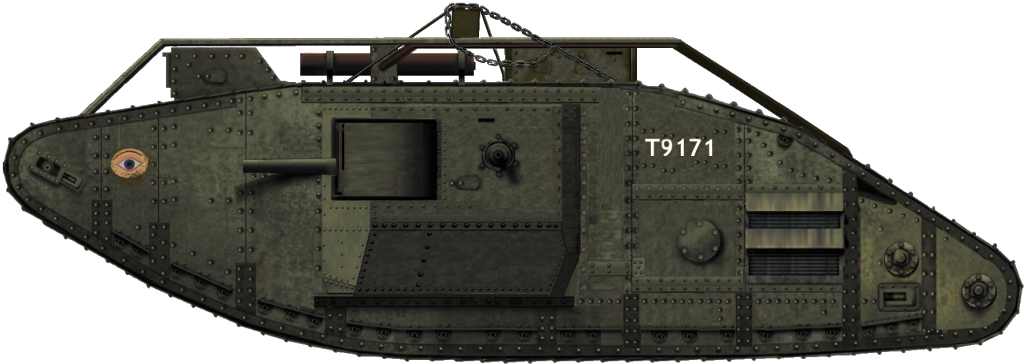
The Mark V was the last evolution of the Mark I lineage, the brainchild of William Tritton and Major Wilson. Here is a standard Mark V male, early production, May 1917. Notice the factory standard dark olive livery and the “eye” painted on the front, a reference to the “eyes” of ancient ships.
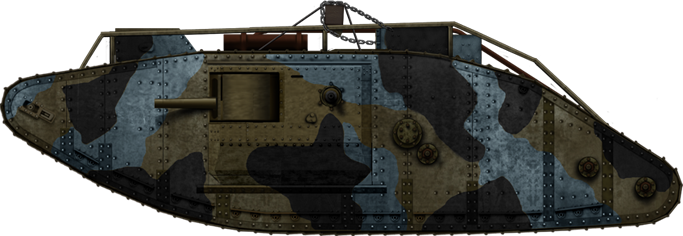
A camouflaged late Mark V hermaphrodite. On the other side, a machine-gun sponson was fitted. Multi-pattern liveries were applied on site, with provisional, regulated colors. White, pale blue, brown, dark grey, black, were commonly used in spotted patterns, with or without black borders (French 1918 standard livery). The last Mark Vs were delivered well after the armistice.
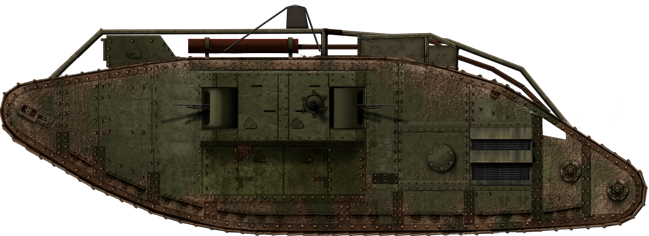
Modified Mark V
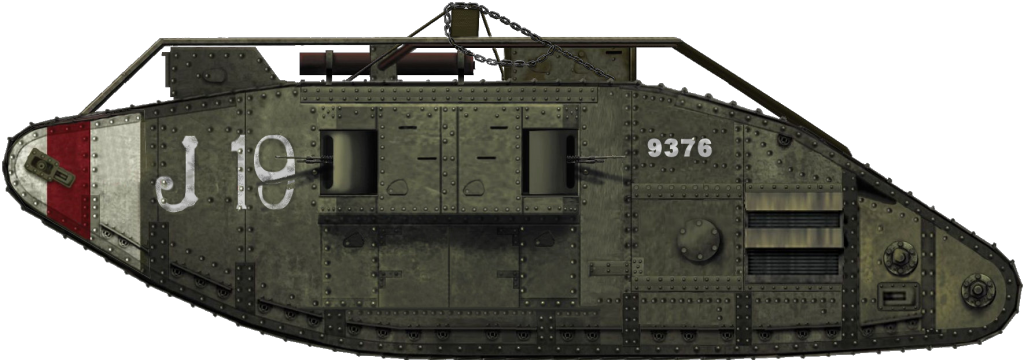
Tank Mark V composite
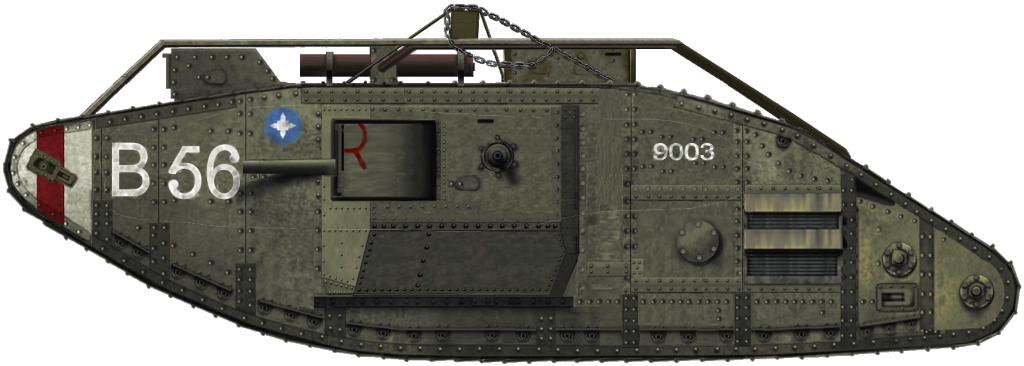
Mark V Male tank No.9003 B56 named Barrhead, was part of the C Company, 2nd Battalion. On 8th August 1918 it saw action when it attacked the enemy defensive lines and reached the Blue line objective before returning to Allied liens. It was photographed several times as it moved forward from La Motte en Santerre. It carried a flag indicating that it may have been used as a command tank. It was back in action on 9th August 1918 but as it attacked it was hit and set on fire. Two of the tank crew were killed instantly, four were wounded but one of them died later of his wounds. It was recovered and repaired. On 2nd of June 1920 it was used by the White Russian Army, 1st Tank Detatchment, 1st Tank Division. On 1st January 1921 it was captured by the Red Russian Army.
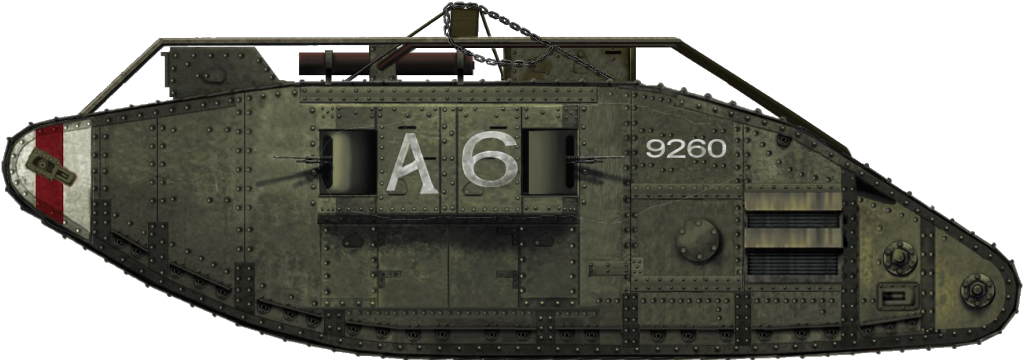
On 10th August 1918 Female Mark V tank No.9260 was photographed during the kings visit to Sautercourt when it took part in infantry and tank cooperation exercises. It displayed the hand painted identification number A6 on its sponson. It was fitted with an unditiching beam and rails. On 2nd September 1918, under the command of 2nd Lieutenant Lockwood, as part of the 14th Battalion, Tank Corps it went into battle, It reached and passed the 1st objective but was hit and burnt out just prior to the 2nd objective.
 The Mark V* star and Mk.V** double star, were lengthened versions designed to assault the Hindendurg line, presenting very large antitank trenches. Attempts to use the larger hull to transport some infantry were doomed to fail due to the extreme conditions inside. It was hot, extremely noisy and filled with poisonous gases, not counting the shrapnel produced at every impact. The soldiers started feeling ill long before the tanks reached their destination. The Mark V** was equipped with a new engine and new tracks, but none were completed before the war ended.
The Mark V* star and Mk.V** double star, were lengthened versions designed to assault the Hindendurg line, presenting very large antitank trenches. Attempts to use the larger hull to transport some infantry were doomed to fail due to the extreme conditions inside. It was hot, extremely noisy and filled with poisonous gases, not counting the shrapnel produced at every impact. The soldiers started feeling ill long before the tanks reached their destination. The Mark V** was equipped with a new engine and new tracks, but none were completed before the war ended.
 The Female Mark V* Star tank with the unditching beam rails was used by the US 301st Battalion during their first battle that involved crossing the Hindenburg Line near Le Catalet and Saint-Quentin on 29th September 1918. They used sixteen Mark V* Star Male tanks and four Mark V* Star Female tanks.
The Female Mark V* Star tank with the unditching beam rails was used by the US 301st Battalion during their first battle that involved crossing the Hindenburg Line near Le Catalet and Saint-Quentin on 29th September 1918. They used sixteen Mark V* Star Male tanks and four Mark V* Star Female tanks.
 The Male Mark V* Star tank armed with two 6pdr guns. The 15th Tank Battalion crewed 36 elongated Mark V* Star Tanks at the Battle of Amines 8th – 12th August 1918.
The Male Mark V* Star tank armed with two 6pdr guns. The 15th Tank Battalion crewed 36 elongated Mark V* Star Tanks at the Battle of Amines 8th – 12th August 1918.
 The Male Mark V* Star tank with the unditching beam rails.The Canadian 1st Tank Battalion fielded 36 of the new elongated Mark V* Star tank at the Battle of Amines 8th – 12th August 1918.
The Male Mark V* Star tank with the unditching beam rails.The Canadian 1st Tank Battalion fielded 36 of the new elongated Mark V* Star tank at the Battle of Amines 8th – 12th August 1918.
 The Mark V* Star tank No.9834 called ‘Orient Unit number 054″ was attached to C Company, 15th Battalion, Tank Corps. It was commanded by 2nd Lieutenant H.Ayres. During the Australian infantry advance near the Somme river in 1918, it was photographed returning back to Allied lines behind three other Mark V* tanks, two of which were being towed.
The Mark V* Star tank No.9834 called ‘Orient Unit number 054″ was attached to C Company, 15th Battalion, Tank Corps. It was commanded by 2nd Lieutenant H.Ayres. During the Australian infantry advance near the Somme river in 1918, it was photographed returning back to Allied lines behind three other Mark V* tanks, two of which were being towed.
 This Mark V* Star Tank took part in the Battle of Amiens on 8 August 1918, serving in B Company, 15th Battalion, under the command of Lieutenant R.P. Foster. It was photographed in the tank park outside the village of Villers-Bretonneux on 28th June 1919 with the letters HQ painted on the sponson hatch. It was not fitted with the unditching rail and beam. During the battle, it crossed no-mans-land but broke down before reaching the green line objective. It was repaired and continued the attack reaching all three objectives. It was hit but rallied and returned to Allied lines.
This Mark V* Star Tank took part in the Battle of Amiens on 8 August 1918, serving in B Company, 15th Battalion, under the command of Lieutenant R.P. Foster. It was photographed in the tank park outside the village of Villers-Bretonneux on 28th June 1919 with the letters HQ painted on the sponson hatch. It was not fitted with the unditching rail and beam. During the battle, it crossed no-mans-land but broke down before reaching the green line objective. It was repaired and continued the attack reaching all three objectives. It was hit but rallied and returned to Allied lines.
 The Mark V** (two star) tank, 1919. Only 25 were built. Notice the side door was much bigger than the hatch on the Mark V* (star) tank.
The Mark V** (two star) tank, 1919. Only 25 were built. Notice the side door was much bigger than the hatch on the Mark V* (star) tank.
 The female version of the Tank Mark V** (two star).
The female version of the Tank Mark V** (two star).
 The Mark VII tank with “tadpole” long tail, 1919. The three tanks that were built were used for experiments. They did not see combat.
The Mark VII tank with “tadpole” long tail, 1919. The three tanks that were built were used for experiments. They did not see combat.
 The Mark VII tank with “tadpole” tail and unditching beam rails
The Mark VII tank with “tadpole” tail and unditching beam rails
 Mark IX in its regular livery, Somme sector, October 1918
Mark IX in its regular livery, Somme sector, October 1918
 Camouflaged Mark IX “Pig” in 1919.
Camouflaged Mark IX “Pig” in 1919.
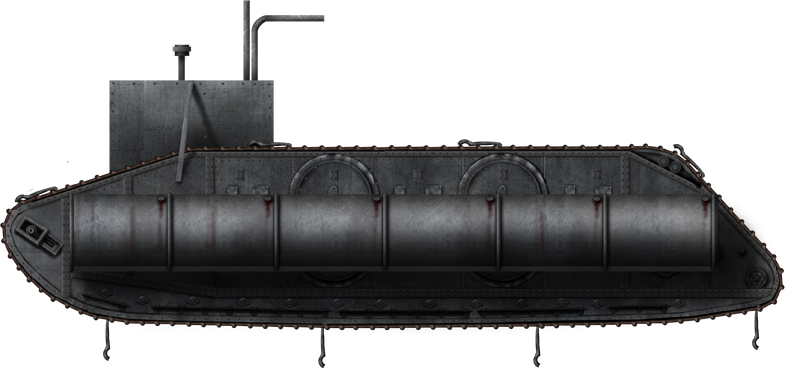 Amphibious Mark IX “Duck” during tests, Devon.
Amphibious Mark IX “Duck” during tests, Devon.
 The Little Willie, as it appeared after its final modifications, in December 1915. Since the first Lincoln machine trials it was fitted with an extra tail-wheel to enhance steering and for crossing large trenches. This feature was successful and retained for the subsequent Mk.I British tank. The specially designed track system was also considered a success. Unlike the previous design, the longer tracks made it better able to cross all kind of difficult, muddy ground, especially trenches and the removal of the turret added some stability.
The Little Willie, as it appeared after its final modifications, in December 1915. Since the first Lincoln machine trials it was fitted with an extra tail-wheel to enhance steering and for crossing large trenches. This feature was successful and retained for the subsequent Mk.I British tank. The specially designed track system was also considered a success. Unlike the previous design, the longer tracks made it better able to cross all kind of difficult, muddy ground, especially trenches and the removal of the turret added some stability.
 Recent photographs taken of the underneath of Little Willie has revealed the remains of green paint. Prior to the establishment of the Tank Museum at Bovington, British Army tank maintenance work shops had the responsibility of looking after this historic tank prototype. After WW1 most British tanks were painted green. The workshops had lots of green paint in stock so Little Willie was painted green. It was only after research in the archives was it repainted its original grey colour and put on display in the Tank Museum.
Recent photographs taken of the underneath of Little Willie has revealed the remains of green paint. Prior to the establishment of the Tank Museum at Bovington, British Army tank maintenance work shops had the responsibility of looking after this historic tank prototype. After WW1 most British tanks were painted green. The workshops had lots of green paint in stock so Little Willie was painted green. It was only after research in the archives was it repainted its original grey colour and put on display in the Tank Museum.
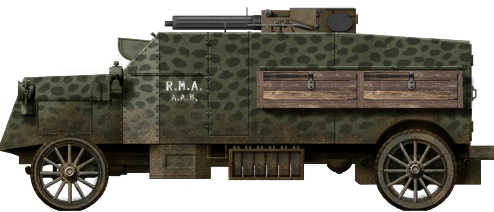
Pierce Arrow with the RMA, 1915 or 1916, with a camouflage livery.
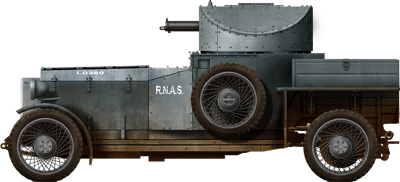 Rolls Royce Mk.I 1914 Pattern, RNAS, Dunkirk, February 1915.
Rolls Royce Mk.I 1914 Pattern, RNAS, Dunkirk, February 1915.
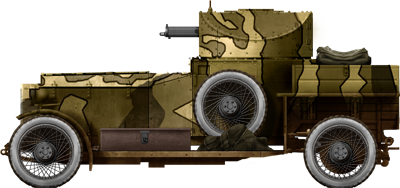 Camouflaged Rolls Royce Mk.I 1914 Pattern, Egypt, 1916.
Camouflaged Rolls Royce Mk.I 1914 Pattern, Egypt, 1916.
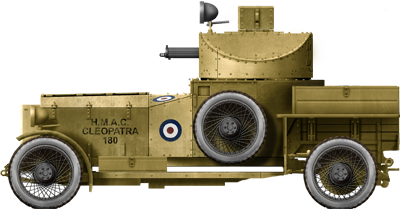 T.E. Lawrence’s Rolls Royce Mk.I 1914 Pattern, Palestine, 1917.
T.E. Lawrence’s Rolls Royce Mk.I 1914 Pattern, Palestine, 1917.
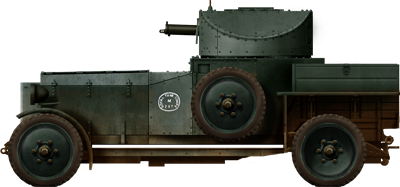 British army Rolls Royce Mk.I 1920 Pattern, sent in Ireland in 1922. Now preserved at Bovington.
British army Rolls Royce Mk.I 1920 Pattern, sent in Ireland in 1922. Now preserved at Bovington.
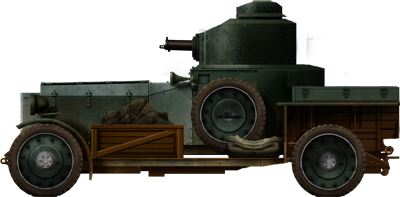 Mk.I 1924 Pattern, Great Britain, 1929. Others served in Egypt until 1940.
Mk.I 1924 Pattern, Great Britain, 1929. Others served in Egypt until 1940.
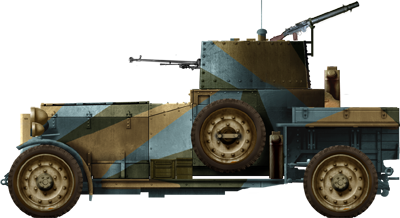 Rolls-Royce 1924 Pattern with a modified open-top turret in Eastern Africa, 1941.
Rolls-Royce 1924 Pattern with a modified open-top turret in Eastern Africa, 1941.
 Gun Carrier Mark I (1917) with the 60-pounder.
Gun Carrier Mark I (1917) with the 60-pounder.
 Gun carrier converted as an ammo supply tank
Gun carrier converted as an ammo supply tank
 Mark IV Male of an unknown unit, St Omer, May 1918. regular dark khaki livery. Notice the three white and red bands and the crew symbol (the “red hand”). Modifications compared to the Mark I included reinforced armor, a relocated fuel tank, an extra front machine-gun and better trench crossing equipment.
Mark IV Male of an unknown unit, St Omer, May 1918. regular dark khaki livery. Notice the three white and red bands and the crew symbol (the “red hand”). Modifications compared to the Mark I included reinforced armor, a relocated fuel tank, an extra front machine-gun and better trench crossing equipment.
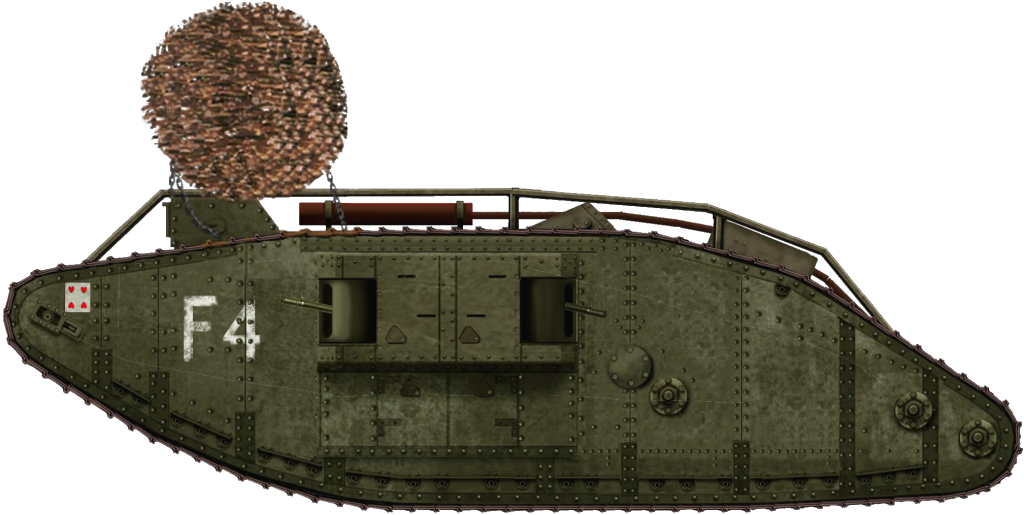 Mark IV Female, equipped with Lewis machine-guns, Ypres, July 1917. Trench crossing capabilities were relatively good due to the very large rhomboid tracks, but the power-to-weight ratio was so feeble that big slopes and deep craters proved impassable, and various solutions were tested. Among them a pair of very large arms (attached to the front), each fitted with a roller and a long “tadpole tail” at the rear, but both solutions proved costly and unpractical. A simpler idea proved successful: a pair of parallel rails, running over the roof, sustaining a very large fascine or an unditching beam. The fascine were also used to assault the antitank trenches of the Hindenburg line.
Mark IV Female, equipped with Lewis machine-guns, Ypres, July 1917. Trench crossing capabilities were relatively good due to the very large rhomboid tracks, but the power-to-weight ratio was so feeble that big slopes and deep craters proved impassable, and various solutions were tested. Among them a pair of very large arms (attached to the front), each fitted with a roller and a long “tadpole tail” at the rear, but both solutions proved costly and unpractical. A simpler idea proved successful: a pair of parallel rails, running over the roof, sustaining a very large fascine or an unditching beam. The fascine were also used to assault the antitank trenches of the Hindenburg line.
 Mark IV Female, equipped with five Hotchkiss Mk.I machine-guns
Mark IV Female, equipped with five Hotchkiss Mk.I machine-guns
 Mark IV Male “Kelly’s Heroes”, Palestinian campaign, battle of Megiddo, 21 September 1918. Around 200 Mark IV were sent by order of General Allenby to this sector to help the breaking through of the Turkish lines towards Jordan. As the conditions in the desert were largely different than those in Europe, the rail and unditching beam were dismounted. The flat ground allowed better speed, but because of the scorching heat the engine overheated and crew comfort suffered.
Mark IV Male “Kelly’s Heroes”, Palestinian campaign, battle of Megiddo, 21 September 1918. Around 200 Mark IV were sent by order of General Allenby to this sector to help the breaking through of the Turkish lines towards Jordan. As the conditions in the desert were largely different than those in Europe, the rail and unditching beam were dismounted. The flat ground allowed better speed, but because of the scorching heat the engine overheated and crew comfort suffered.
 The Mark IV Male tank ‘Hyacinth’ H45 of H Battalion, 24th Company, 10 Sec was ditched in a German trench while supporting the 1st Battalion, Leicestershire Regiment, one mile west of Ribecourt. It was commanded by 2nd lieutenant F.H. Jackson. It reached the starting point and the 1st objective as it attacked the Hindenburg Line trench system. Notice the red letter Z hand painted over the vision slit in an effort to conceal its locations from snipers and machine gunners.No white red and white identification stripes at the front yet as German tanks or Beutepanzers had not been encountered on the battlefield yet. 20 November 1917, Battle of Cambrai.
The Mark IV Male tank ‘Hyacinth’ H45 of H Battalion, 24th Company, 10 Sec was ditched in a German trench while supporting the 1st Battalion, Leicestershire Regiment, one mile west of Ribecourt. It was commanded by 2nd lieutenant F.H. Jackson. It reached the starting point and the 1st objective as it attacked the Hindenburg Line trench system. Notice the red letter Z hand painted over the vision slit in an effort to conceal its locations from snipers and machine gunners.No white red and white identification stripes at the front yet as German tanks or Beutepanzers had not been encountered on the battlefield yet. 20 November 1917, Battle of Cambrai.
 Male Mark IV tank 2021 C24/C23 Crusty captured. Notice the artwork at the rear and the pattern on the sponson to confuse German snipers as to where the vision ports were.
Male Mark IV tank 2021 C24/C23 Crusty captured. Notice the artwork at the rear and the pattern on the sponson to confuse German snipers as to where the vision ports were.
 British Mk.IV Female tank No.4651 “CONQUEROR II” C47 of C Battalion, 9th Company, went into battle on 20th November 1917. It was commanded by 2nd Lieutenant W.Moore. The tank attacked the enemy and successfully returned to Allied lines. On 23rd November 2nd Lt W.Moore lead his tank crew into battle again. Whilst attacking German positions the tank was knocked out by a penetrating armour piercing AP shell that set the tank on fire. It was photographed burnt out in Fontaine-Notre-Dame. On the right hand side of the tank the crew had painted a caricature of a frightened looking German Solider. In April 1918 it was photographed again in No.21 German tank repair workshops
British Mk.IV Female tank No.4651 “CONQUEROR II” C47 of C Battalion, 9th Company, went into battle on 20th November 1917. It was commanded by 2nd Lieutenant W.Moore. The tank attacked the enemy and successfully returned to Allied lines. On 23rd November 2nd Lt W.Moore lead his tank crew into battle again. Whilst attacking German positions the tank was knocked out by a penetrating armour piercing AP shell that set the tank on fire. It was photographed burnt out in Fontaine-Notre-Dame. On the right hand side of the tank the crew had painted a caricature of a frightened looking German Solider. In April 1918 it was photographed again in No.21 German tank repair workshops
 Six Mark IV tanks were used to raise money for the war effort. They toured the towns and cities of Great Britain from November 1917 to the end of WW1 on 11th November 1918. This was an encouragement for people to buy government War Bonds and War Savings Certificates. This tank is No.130 Nelson tank and was on display in Trafalgar Square, London.
Six Mark IV tanks were used to raise money for the war effort. They toured the towns and cities of Great Britain from November 1917 to the end of WW1 on 11th November 1918. This was an encouragement for people to buy government War Bonds and War Savings Certificates. This tank is No.130 Nelson tank and was on display in Trafalgar Square, London.
 Beutepanzer Mark IV Male. By the beginning of the summer in 1918 the Germans had recovered a large number of abandoned Allied tanks. After the successes of the Spring Offensive in 1918 and the recapturing of most of the November 1917 Cambrai battlefield, over 300 damaged tanks were now situated behind German lines. Over 100 British Mark IV tanks were refurbished and prepared to fight for their new masters. They were called Beutepanzers (Trophy tanks).
Beutepanzer Mark IV Male. By the beginning of the summer in 1918 the Germans had recovered a large number of abandoned Allied tanks. After the successes of the Spring Offensive in 1918 and the recapturing of most of the November 1917 Cambrai battlefield, over 300 damaged tanks were now situated behind German lines. Over 100 British Mark IV tanks were refurbished and prepared to fight for their new masters. They were called Beutepanzers (Trophy tanks).
 BeutepanzerWagen IV(b) female Large German Army black crosses, a type of Christian cross with arms that narrow in the centre and have a white border called a ‘Bundeswehr Schwarzes Kreuz’ were painted on the captured tanks to identify the fact that they were under new management. The design of the German identification black cross changed in the second half of 1918 to the ‘Balkenkreuz’ (beam or bar cross). Some of the later repaired Beutepanzers had this newer cross design painted on their sides instead.
BeutepanzerWagen IV(b) female Large German Army black crosses, a type of Christian cross with arms that narrow in the centre and have a white border called a ‘Bundeswehr Schwarzes Kreuz’ were painted on the captured tanks to identify the fact that they were under new management. The design of the German identification black cross changed in the second half of 1918 to the ‘Balkenkreuz’ (beam or bar cross). Some of the later repaired Beutepanzers had this newer cross design painted on their sides instead.
 Supply Mark IV “Auld Reekie” The Army needed a method of resupplying the tanks on the battlefield and the simplest option was to build new or convert old tanks into supply tanks. Their armoured hulls would protect the crew and the stores it was transporting. As it was a tracked vehicle it could cross the same terrain that the battle tanks were driving across.
Supply Mark IV “Auld Reekie” The Army needed a method of resupplying the tanks on the battlefield and the simplest option was to build new or convert old tanks into supply tanks. Their armoured hulls would protect the crew and the stores it was transporting. As it was a tracked vehicle it could cross the same terrain that the battle tanks were driving across.
Tank Mk.VIII Liberty
by
Giganaut American Mark VIII Liberty, US Infantry’s 67th Armored Regiment, Aberdeen, Maryland.
American Mark VIII Liberty, US Infantry’s 67th Armored Regiment, Aberdeen, Maryland.
 Prospective view of a British Mark VIII, as it could have looked if deployed during the great summer offensive of 1919.
Prospective view of a British Mark VIII, as it could have looked if deployed during the great summer offensive of 1919.
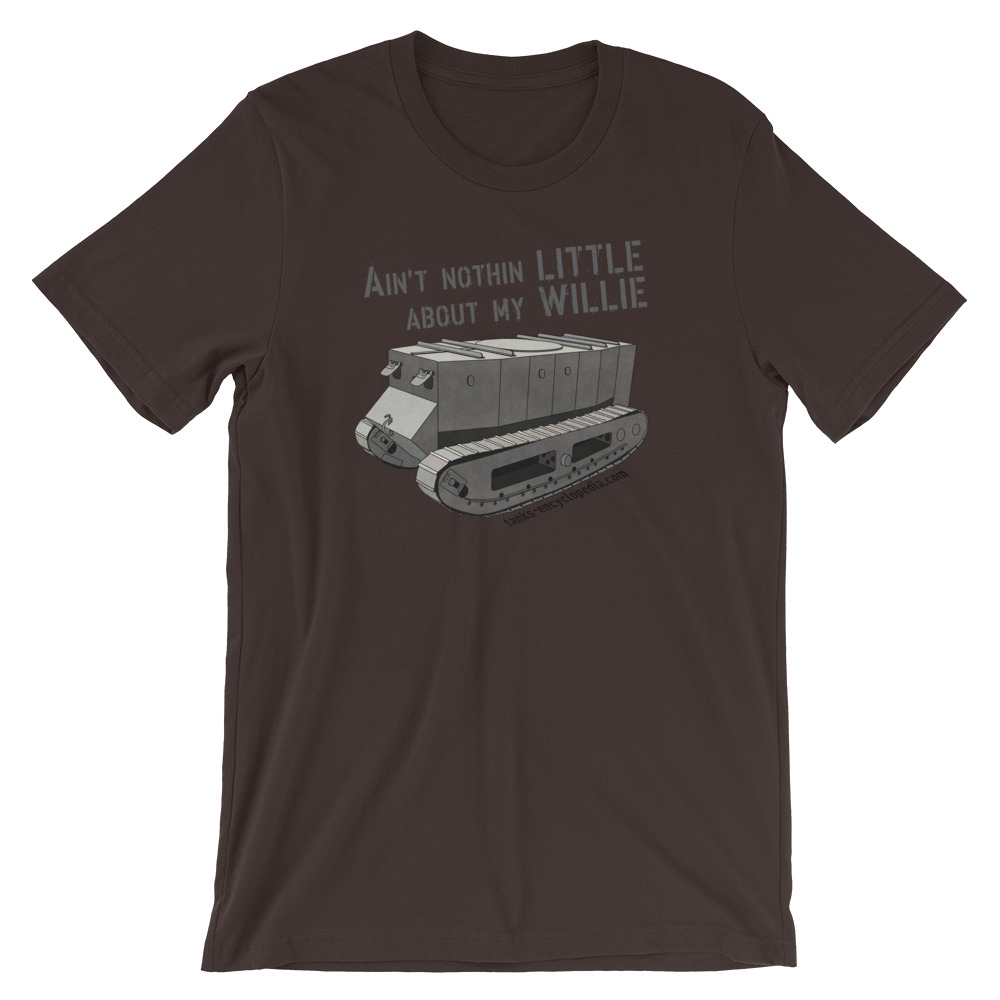
Little Willie – Tank Encyclopedia Support Shirt
Little Wille, the first tank prototype, features prominently in this snark shirt! A portion of the proceeds from this purchase will support Tank Encyclopedia, a military history research project. Buy this T-Shirt on Gunji Graphics!

Col. R.E.B. Crompton (Pioneers of Armour)
The foundations and principles of modern armoured warfare did not appear out of a vacuum, and nor did the machines of WW1 and WW2. Their development was full of false starts, failed ideas, and missed opportunities. Rookes Evelyn Bell Crompton was a pioneer in electrical engineering and road haulage who, by the turn of the century found himself in South Africa during the Boer War. Later, in WW1 his early work with the Landships Committee on tracked vehicles sought to break the stalemate of trench warfare. Although his tank designs never saw combat the work he started was carried on by other pioneers and helped to usher in a dawn of armoured and mechanised warfare.

Robert Macfie (Pioneers of Armour)
The foundations and principles of modern armoured warfare did not appear out of a vacuum, and nor did the machines of WW1 and WW2. Their development was full of false starts, failed ideas, and missed opportunities. Robert Macfie was a pioneer in aviation at the turn of the century followed by work with the Landships Committee on tracked vehicles to break the stalemate of trench warfare. Although his tank designs never saw combat the work he started was carried on by other pioneers and helped to usher in a dawn of armoured and mechanised warfare.

Provisional Handbook of the Chaser Mark I: Whippet Tank Service Manual
In 1916, the British Army had started using tanks in battle in an attempt to break the deadlock of trench warfare. These large lumbering Heavy Tanks were slow and unable to exploit weaknesses in enemy lines or a breakthrough. What was needed was a new ‘Medium’ Tank, and the Lincolnshire firm of William Foster and Co., the brains behind the Heavy Tanks set to work on a new Medium vehicle. By February 1917, this new vehicle, known as the Tritton Chaser or ‘Whippet’ was ready in prototype form. Two hundred of these Whippet tanks, officially known as the Medium Mark A were produced. This manual dates to the early days of the Whippet as it was being produced for the Tank Corps. A guide to the operation and maintenance of this new, smaller, and faster tank.
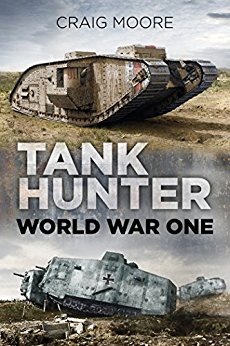
Tank Hunter: World War One
The First World War’s fierce battles saw the need to develop military technology beyond anything previously imagined: as exposed infantry and cavalry were mowed down by relentless machine-gun attacks, so tanks were developed. Stunningly illustrated in full colour throughout, Tank Hunter: World War One provides historical background, facts and figures for each First World War tank as well as the locations of any surviving examples, giving you the opportunity to become a Tank Hunter yourself.

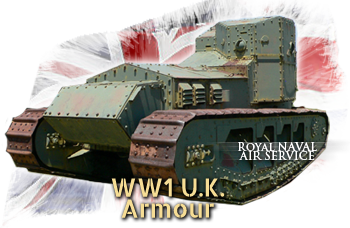



































































10 replies on “United Kingdom of Great Britain and Ireland (WW1)”
An account from my great uncle, Joseph McPherson’s original War diaries 08/04/1917 at the EEF advance at Gaza may be interest: “We visited eight tanks which have just come up, and I spent about an hour inside one of them called ‘War Baby’, a 105 H.P. youngster with four Hetchkisses and two auxiliary guns. I was much interested in War Baby, its guns, revolver, loop holes, periscopes, dynamoes, differentiator etc. The personnel consisted of one Officer who sits y the driver, four gunners on bike seats and two greasers, eight in all (1 Officer, 3 NCOs and 5 men)..
(Wider writings are published in Bimbashi Joseph McPherson: a Life in Egypt, BBC Publications 1983).
“This was the world’s first SPG (self-propelled gun),….” not so world’s “first” considering and other constructors of self-propelled guns before 1916
William Foster and Co. was in Lincoln, England not Scotland. Early trials were carried out in Burton, just outside Lincoln.
love the world of tanks ad
We have no world of tanks ad on this page. The ad you are seeing is coming from Google Ads based on your own preferences.
I would recommend a article about Mark D tank too. Becuase this tank was also to be one of the tank project in WW1
What happen where did the article about Mark IV go. Is it gone?
It is withdrawn for now, yes.
Why do you guys withdrawal articles, (unless they are wrong about things)? I was looking for the one on the RU 251, but it appears to be gone.
Because they are horribly wrong.